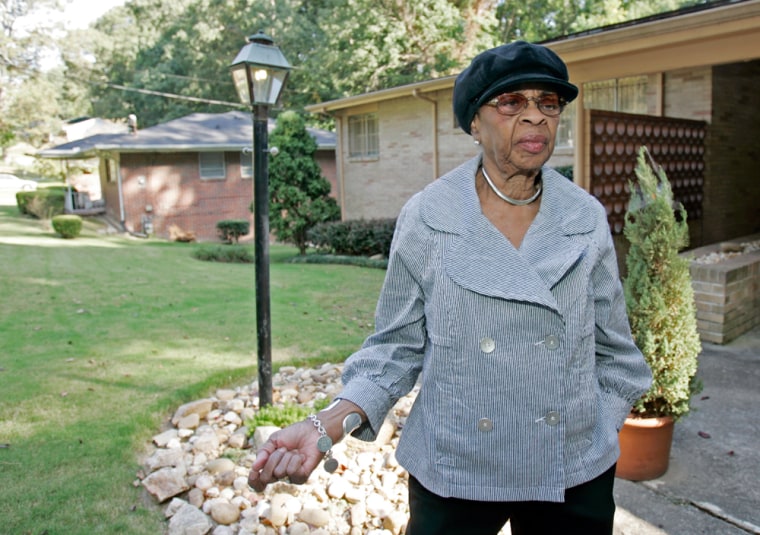The spacious ranch and split-level homes with manicured lawns spreading for block after block in northwest Atlanta's Collier Heights were the very picture of mid-century American suburbia. The black families who moved into them were not.
Built at the end of Jim Crow, Collier Heights stood as a testament to Atlanta's black elite and powerful, home to civil rights leaders, educators, lawyers and entrepreneurs. Today, supporters of the neighborhood are vying to put the first major black suburb built after World War II on the National Register of Historic Places.
"It was one of the first in the country created by and for African Americans," said Richard Laub, an historical preservationist at Georgia State University. "The African American community was flexing their muscles."
This week, Collier Heights has been highlighted by the Docomomo/U.S. society, which promotes conservation of buildings and architectural styles from the Modern Movement. The Georgia chapter planned a driving tour of those homes Saturday in this southern city, bastion of a sizable black middle class.
The idyllic setting was what black business and civic leaders envisioned decades ago.
In the mid 1940s, the group went to the white city fathers with a plan they called "Proposed Areas for Negro Expansion," said Andrew Wiese, a history professor at San Diego State University and author of the book "Places of Their Own: African American Suburbanization in the 20th Century."
"Through some really interesting wrangling and politics, by using whites' racism against them, they were able to make strategic purchases of property," Wiese said. "They engaged in this sort of under-the-radar process at attempting to gain the west side for the black middle class, and they won."
Homes of distinction
For generations before, even middle- and upper-class blacks were confined to the cramped inner city. But from the 1920s through the 1940s, they began buying up tracts outside the city limits to build their version of suburbia, with large lawns and airy homes.
They spent years acquiring land on Atlanta's west side in hopes of improving housing options in the city — and for blacks in particular. In the end nearly 2,000 homes were built.
A cabal of black doctors, lawyers, civil rights leaders, educators and entrepreneurs flocked to seize this corner of the city for themselves, after agreeing to settle in a segregated but equal setting.
A Who's Who of black Atlanta called Collier Heights home: the Rev. Martin Luther King Sr.; Ralph David Abernathy, an ally of Martin Luther King Jr. in the Southern Christian Leadership Conference; prominent civil rights attorney Donald Hollowell; and entrepreneur Herman Russell.
Some of the homes were as distinctive as their residents: one is dubbed the "pagoda ranch" for its Asian influence and another is a unique circular house built of tan brick.
"What we found there was a wide variety of sizes and styles of ranch and split-level houses," Laub said. "There were many that were architect-designed, and some were out of plan books. There's a real diversity."
Laub, who directs the Heritage Preservation Program at Georgia State, taught a class last spring adopting the neighborhood as a case study.
'American Dream'
Though the suburb barely qualifies as historic — the first of its 55 subdivisions weren't built until the 1950s — it was ripe for research in a way that is normally impossible on older districts.
"It's very rare to be able to talk to the people who settled the neighborhood," Laub said. "In talking to the residents, this was really their piece of the American Dream."
Gigi Dickens felt like she and her husband, Robert, had arrived when they moved into the Woodlawn Heights section of the neighborhood in 1961, next door to her brother. She was a public schoolteacher and her husband worked for the federal housing department.
"We used to have a great, big neighborhood picnic," Gigi Dickens said, boasting that her brother had a huge barbecue pit that was popular for gatherings. "We would get together for holidays, we knew each other's birthdays. It was a very close-knit neighborhood."
Today, the neighborhood is not what it was a few decades ago.
Its richest resource — the many original residents — are aging and unable to maintain the homes in their former grandeur. Younger prospective residents now have their choice of where to live in Atlanta. Crime has also become an issue, as evidenced by iron bars now covering some of homes' entries.
'So glad to be included'
Still, those who remain know they are part of something unique, said Richard Cloues, who works for the state historic preservation office.
He is preparing Collier Heights' application for the National Register.
"It was on land owned by African Americans, financing was provided by African American institutions, much of the development that took place, many of the contractors, and all of the people who bought houses were African American," he said.
Organizers expect Collier Heights will be listed on the National Register in a few months. They say the listing is more of a recognition that raises public awareness of a neighborhood's history and allows those who restore area homes under federal guidelines to take advantage of certain tax breaks.
It could also open the way for Atlanta leaders to designate Collier Heights as a local historic district, protecting the suburb from demolition, new construction or changes that would alter the neighborhood's character.
Looking back on the suburb's founding, Gigi Dickens recalled how word of mouth spread quickly when Collier Heights was being built. Soon the neighborhood was populated with many of Atlanta's black and educated middle class seeking spacious properties of their own.
"This was more of a sophisticated area," she said. "The homeowners were black and professional people. It was a big deal. I was so glad to be included."
In the end, it was the exclusion of Dickens and her neighbors from a society that made her neighborhood exclusive.
